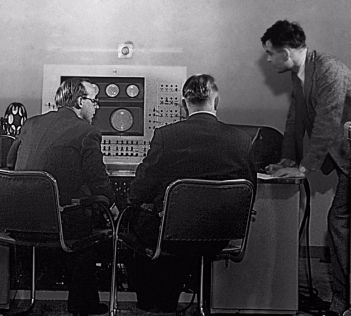| Turing's Computer Music |
| Written by Historian | |||
| Saturday, 01 October 2016 | |||
|
An often overlooked facet of the Alan Turing story is that he was the first to generate musical notes using a computer. This was as early as 1948 on the Manchester Mark I. A recording of the first computer music, made in 1951, by the BBC has been restored by Jack Copeland and Jason Long and we can now hear it.
The story of how the music came to be made and the work required to restore it is told by Jack Copeland, author of Turing, Pioneer of the Information Age, and Jason Long, a composer who and performer, focusing on musical robotics and electro-acoustic music. This extract is taken from Restoring the first recording of Alan Turing's computer music. In 1951, a BBC outside broadcast unit in Manchester used a portable acetate disc cutter to capture three melodies played by a primeval computer. This gigantic computer filled much of the ground floor of Alan Turing's Computing Machine Laboratory. Today, all that remains of the recording session is a 12-inch single-sided acetate disc, cut by the BBC's technician while the computer played.
What a disappointment it was, therefore, to discover that the pitches were not accurate: the recording gave at best only a rough impression of how the computer sounded. The Manchester computer had a special instruction that caused the loudspeaker—Turing called it the 'hooter'—to emit a short pulse of sound, lasting a tiny fraction of a second. Turing said this sounded like 'something between a tap, a click, and a thump'. Executing the instruction over and over again resulted in this 'click' being produced repeatedly, on every fourth tick of the computer's internal clock: tick tick tick click, tick tick tick click. Repeating the instruction enough times like this caused the human ear to hear not discrete clicks but a steady note, in fact the note C6, two octaves above middle C. Turing was not very interested in programming the computer to play conventional pieces of music: he used the different notes to indicate what was going on in the computer—one note for 'job finished', others for 'digits overflowing in memory', 'error when transferring data from the magnetic drum', and so on.
Running one of Turing's programs must have been a noisy business, with different musical notes and rhythms of clicks enabling the user to 'listen in' (as he put it) to what the computer was doing. He left it to someone else, though, to program the first complete piece of music. A young schoolteacher named Christopher Strachey got hold of a copy of Turing's Programmers' Handbook for Manchester Electronic Computer Mark II. This was in fact the world’s first computer programming manual. Strachey, a talented pianist, studied the Handbook and appreciated the potential of Turing's terse directions on how to program musical notes We found there was enough information in Turing's wonderfully pithy Programmers' Handbook to enable us to calculate all the audible frequencies that the Mark II could produce. However, when we ran a frequency analysis of the 1951 BBC recording (using the British Library's digital preservation copy, ref. H3942) we found that the frequencies were shifted. We were able to calculate exactly how much the recording had to be speeded up in order to reproduce the original sound of the computer. We also filtered out extraneous noise from the recording; and using pitch-correction software we removed the effects of a troublesome wobble in the speed of the recording (most likely introduced by the disc-cutting process). It was a beautiful moment when we first heard the true sound of Turing's computer.
First recorded computer music - Copeland-Long restoration (click link to hear restored recording from the Manchester Mark I )
More InformationRestoring the first recording of Alan Turing's computer music Turing, Pioneer of the Information Age Related ArticlesAlan Turing's Electronic Brain by Jack Copeland (book review)
To be informed about new articles on I Programmer, sign up for our weekly newsletter, subscribe to the RSS feed and follow us on Twitter, Facebook, Google+ or Linkedin.
Comments
or email your comment to: comments@i-programmer.info |
|||
| Last Updated ( Sunday, 02 October 2016 ) |



